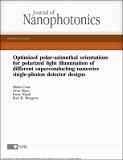Optimized polar-azimuthal orientations for polarized light illumination of different superconducting nanowire single-photon detector designs
Author(s)
Csete, Maria; Sipos, Aron; Najafi, Faraz; Berggren, Karl K.
DownloadCsete-2012-Optimized polar-azim.pdf (2.975Mb)
PUBLISHER_CC
Publisher with Creative Commons License
Creative Commons Attribution
Terms of use
Metadata
Show full item recordAbstract
The optimum orientations were determined for polarized light illumination of three superconducting nanowire single-photon detector (SNSPD) designs consisting of niobium-nitride (NbN) stripes with dimensions according to conventional devices in 200 nm periodic pattern: (1) standing in air (bare-SNSPD), (2) below ∼quarter-wavelength hydrogen-silsesquioxane (HSQ) filled nano-cavity (DC-SNSPD), and (3) below HSQ-filled nano-cavity closed by a thin gold reflector (OC-SNSPD). Computations showed that the optical response and near-field distribution vary significantly with polar angle φ, and these variations are analogous across all azimuthal angles γ, but are fundamentally different in different device designs. Larger absorptance is attainable due to p-polarized illumination of NbN patterns in P-orientation, while s-polarized illumination results in higher absorptance in S-orientation. As a result of p-polarized illumination, a global NbN absorptance maximum appears in bare-SNSPD at polar angle corresponding to attenuated total internal reflection (ATIR); in DC-SNSPD exactly at total internal reflection (TIR); and at perpendicular incidence in OC-SNSPD. S-polarized illumination results in a global NbN absorptance maximum in bare-SNSPD at TIR; in DC-SNSPD at polar angle corresponding to ATIR phenomenon; while large and almost polar angle independent absorptance is attainable in OC-SNSPD at small tilting.
Date issued
2012-11Department
Massachusetts Institute of Technology. Department of Electrical Engineering and Computer Science; Massachusetts Institute of Technology. Research Laboratory of ElectronicsJournal
Journal of Nanophotonics
Publisher
SPIE
Citation
Wissner-Gross, Zachary D. et al. “Synchronous Symmetry Breaking in Neurons with Different Neurite Counts.” Ed. Michal Zochowski. PLoS ONE 8.2 (2013): e54905.
Version: Final published version
ISSN
1934-2608